Whether we’re talking to a set designer, jewelry maker, podcaster, or archivist, these stars’ contributions to our era of fashion are bound to be history-making. Read about their trailblazing energy below.
JACQUES AGBOBLY
At the height of the pandemic, designer Jacques Agbobly founded Agbobly, a destination for Black, immigrant, and queer designers to showcase their work. With a dedicated focus on West African techniques, Agbobly’s output is colorful, intentional, and proud—we can’t wait to see what he does next.

Jacques wears sweater AGBOBLY / Trousers talent’s own
V MAGAZINE: Tell us about your work.
JACQUES AGBOBLY: My work is a love letter to Togo, an exploration of identity through the eyes of an Afropolitan. My debut collection at New York Fashion Week was “Bienvenue à Bord” (“Welcome Aboard”). The collection metaphorically situates itself at the departure gate of the airport in Lomé, where I embarked on the plane that would take me away from Togo, my only home, to reunite with my mother in the cold city of Chicago. Dedicating this collection to reflect on that experience has been incredibly generative. In my collections, color often captures their attention; it’s my chosen medium to deepen and illuminate each story. Every hue is carefully curated, a call to fellow Afropolitans, inviting them to recognize something familiar, something that feels like home.
V: What makes it possible for you to do what you do?
JA: What makes it possible for me to do what I do is community—my unbreakable circle of support. Growing up, I was surrounded by a family that leaned on each other through every season. My grandmother and my aunts were my teachers in the art of togetherness, instilling in me the knowledge that life is a shared experience. When I moved to Chicago, I lived in a housing community that continued to foster those same values I had learned back home in Lomé. My roots are in a housing community where bonds were built out of necessity and love. We all looked out for one another, forming a network of “cousins” and family-like ties, connected by shared spaces and shared lives. It’s these early connections that taught me what it means to belong, to support, and to uplift.
V: When you decided to pursue this passion, was there anything that surprised you?
JA: I quickly realized that dreaming about it was so different from actually living it day to day. The vision I had—the excitement, the creative flow, the freedom—was real, but it didn’t account for the full spectrum of experiences. There are moments of exhilaration, but also ones of exhaustion, unexpected challenges, and self-doubt. I sometimes find myself needing to reconnect with the original dream, to lean back into it as a kind of survival. That initial vision reminds me why I started, and it keeps me grounded and inspired when the reality of the work feels overwhelming.
V: Take your flowers. What’s something you’re proud of that you did this year?
JA: This year, I’m most proud of releasing a collection that has been my labor of love for three years. I lost my brother while working on my most recent collection, and clawing my way out of grief to create something joyful and meaningful was no small feat. The last collection was a dedication to him, honoring his spirit. The next one will be a love letter full of whimsy, heartache, and healing—a reflection on the journey of grieving and growing that I have lived through over the last year and a half. A year ago, I was overwhelmed with questions. I was unsure how I could move forward with my brand and my art. But now, having worked through it, I feel like I’ve reached a place with more answers than questions. I’m ready to continue, with my brother always in mind.
MILENA GORUM
If you’re open to it, you can learn a lot about yourself on set. Take Milena Gorum. For her, modeling at 15 forged the road for a thriving career in set design. Now, her projects fall anywhere on a fabulous spectrum that ranges from Olivia Rodrigo’s stage design for the singer’s SNL performance last year to Rosalia’s Vogue Plus cover this past August.

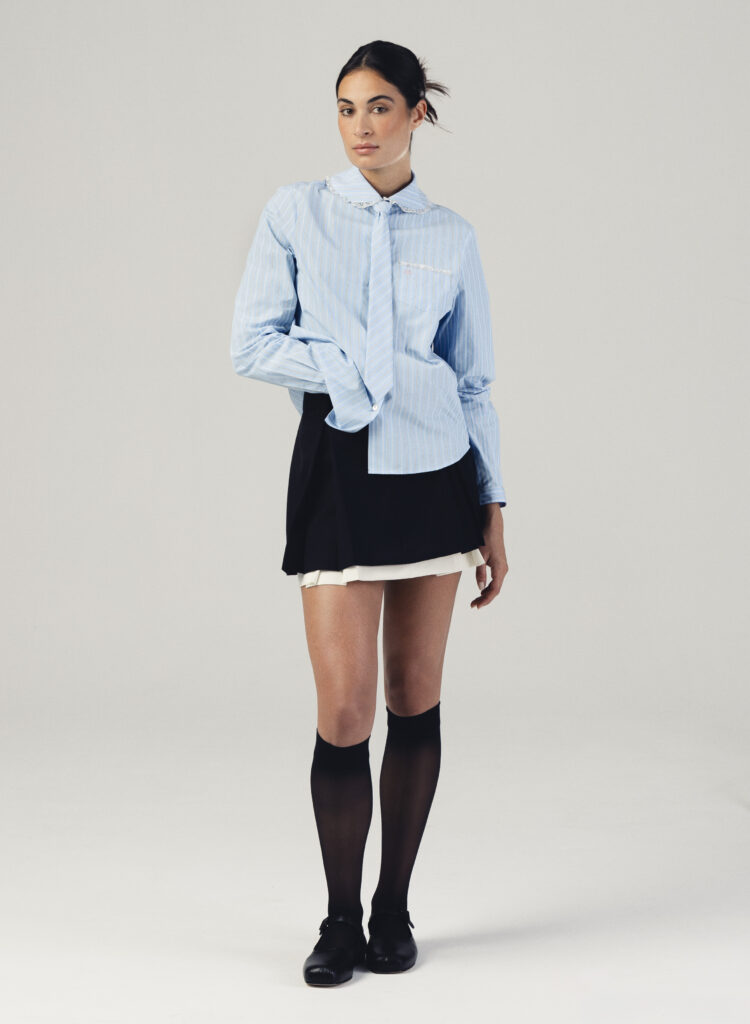
Milena wears button down, tie, skirt SANDY LIANG On lips / NARS Afterglow Lip Shine in Turkish Delight
V MAGAZINE: Tell us about your work.
MILENA GORUM: I’m a set designer, art director, and prop stylist. I design and build sets for commercials, fashion shoots, and music videos. I collaborate with other creatives to flesh out ideas and create real life solutions for conceptual design.
V: When you decided to pursue this passion, was there anything that surprised you?
MG: Realizing the sheer amount of hard, manual labor it takes to do set design was humbling when I first started. Modeling is grueling and relentless on your body in its own way. But I had never experienced what it was like to build out an entire room, then tear it down the same day. I cried after the first job I art assisted on, I couldn’t believe this was the career I was so sure I wanted to pursue, yet it felt like I couldn’t possibly go in the next day. But I did, and now that impossible job was just another job.
V: If you weren’t doing this, what would you be doing?
MG: Director of photography for sure. It’s emotive, world-building, and challenging. It’s arguably the most important role on set.
V: Who should everyone know about?
MG: Crystal Geller, she is an incredible designer. Everything she decides to put out is thoughtful and inspiring. I can’t think of anyone else whose vision is more defined.
V: What is a singular work of art that everyone should experience?
MG: Read The Prophet by Kahlil Gibran or watch Nils Frahm performing “Says” live for BBC, see the first light of sunrise sneak through the cracks in the bathroom of Berghain, sit on the bench in front of a Joan Miró painting at the Pompidou.
V: What possession of yours do you feel best captures your essence?
MG: Years ago, I thrifted a small bracelet, probably from the 70s. It’s a clear plastic band with rusted jingles; it has a small inscription that reads “disco bells.”
V: If you could, what would you say to yourself 15 years ago? What about you 15 years from now? MG: 15 years ago, keep saying yes to everything. 15 years from now, please learn when to say no. V: Take your flowers. What’s something you’re proud of that you did this year?
MG: In May, I had five jobs in three days. It was the most back to back, zero turnaround I’d had in my career. Monday: Thom Browne Met Gala Video. Tuesday: Vogue China cover with Rosalia. Wednesday: Sandy Liang campaign while the Invasive Modification lookbook was shooting simultaneously while I sent my assistants in for a Vogue Taiwan cover. (I had to split my time between these two sets driving back and forth from Red Hook to Bed Stuy.) The workload was overwhelming, but it ended up being a new threshold for myself.
ETIENNE BOLDUC
Etienne Bolduc figured out a way to integrate his fanatical love of Japanese design, deep-fried internet irony, and physics schooling into a single platform: My Clothing Archive. Profiled by GQ, the New York Times, and Business of Fashion, Bolduc, also known as the Digital Cowboy, is the guy to know if you’re into pleats and obscure-yet-objective fashion history.
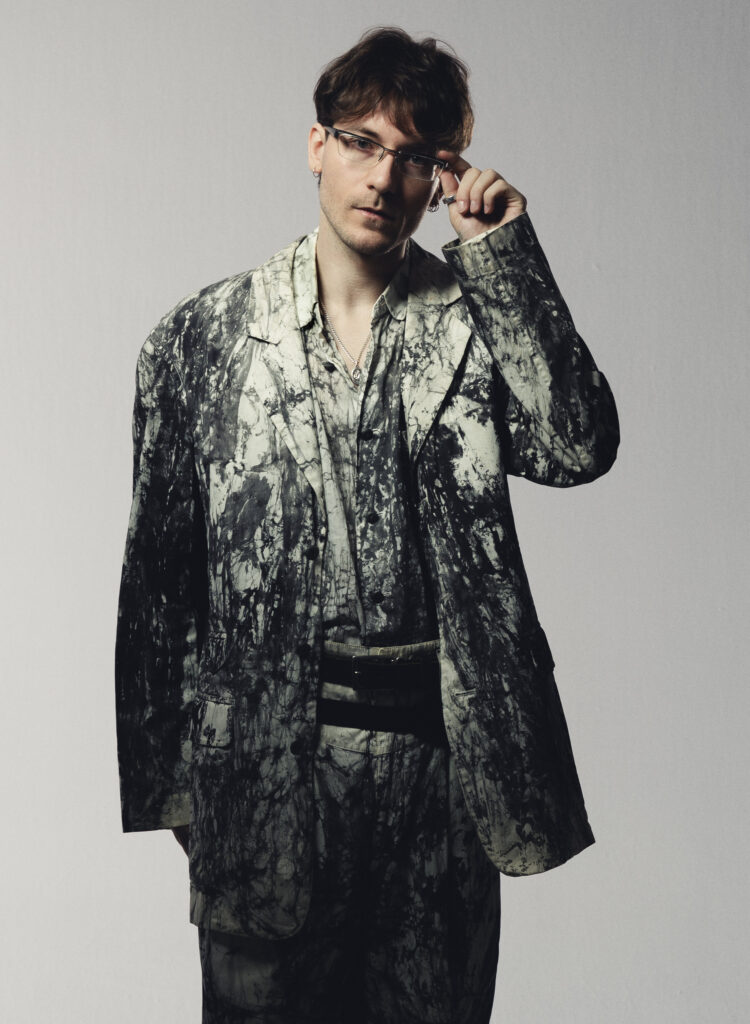
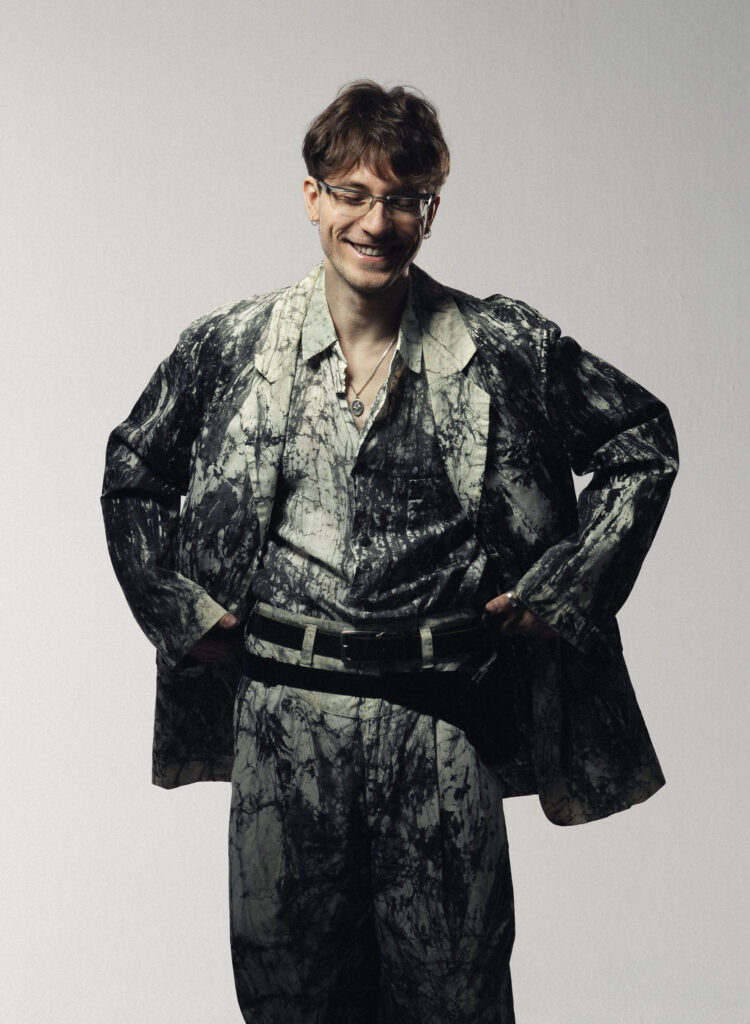
Etienne wears vintage suit MY CLOTHING ARCHIVE
V MAGAZINE: Tell us about your work.
ETIENNE BOLDUC: My work is hard to describe. I can’t even describe it. I used to say I was a fashion collector, but now I say that I’m more of a fashion historian, because I think collectors are mostly people that buy expensive stuff, and they don’t really do much with it. Before doing fashion research, I was actually in physics—condensed matter physics, more specifically.
V: What makes it possible for you to do what you do?
EB: Frustrations. I see problems or I see things that require research, and I try to figure them out because I love solving problems. From an exterior point of view, you might think that my approach is very clinical and very cold and factual and very methodical—which is true, but at the same time, by doing things this way, it makes it clear that I focus on the facts. The way I find these things, I try to honor people’s legacy and the memories of the people that were actually there at the time.
V: When you decided to pursue this passion, was there anything that surprised you?
EB: Every day, I’m surprised. But I will say, the one thing I was most surprised by is that as a single individual, you can have a big impact. Sometimes I find things that no one else has found. Simple things. I found a picture of Satoshi Tajiri, the creator of Pokemon, wearing an Issey Miyake piece. I know the designer who was there at the time, so I sent him a message. I was like, hi, Naoki. I just found a picture of the creator of Pokemon wearing one of your pieces, did you know about this?
V: If you weren’t doing this, what would you be doing?
EB: I’m thinking about maybe going back into physics a bit more. I like doing research. Honestly, I would research any subject. And I would have the same process and the same respect. I also build tech tools. For example, I mostly collect three brands: Yohji Yamamoto, Issey Miyake, and Comme des Garcons. And for the three brands, I’ve created identification software. If someone doesn’t know how to identify their piece, they can go on my website, enter their information, and get the exact collection of the piece. It’s super useful for people who’ve just started collecting.
V: Best piece of advice you’ve ever received?
EB: Someone told me it’s important to be brave. And I really thought about what it means for me to be brave and take risks. I don’t do it as much as I think I do it. It’s simple, but it’s important.
V: This is a new year’s issue. What do you want to accomplish in the new year?
EB: Maybe one thing I would do is be even more behind the scenes. I would like to be a ghost and do great things without anyone knowing. It’s hard to describe, but I just want to do good work and use my years of research and knowledge in these decades of fashion to help push forward design. Because I collect the past—and I’m fully aware that these things are from the past—I want to build on the past. People often copy the past, but they don’t build on it. They create a cheaper version of it—like a pastiche of the past. So, I think that’s the thing. To help push design further than that so that it’s not pastiche, but so that we’re actually building on top of the past.
ANDREW DAHLING
Last summer, Chappell Roan went viral after she performed at Gov Ball as Lady Liberty. It was Andrew Dahling, makeup mastermind, who not only coated the popstar in a verdigris hue, but he also gave her an impeccable rich green contour to match. Inspired by the cartoonish club kids of yesteryear, this artist is bringing a fresh, yet informed, take on glam as we know it.

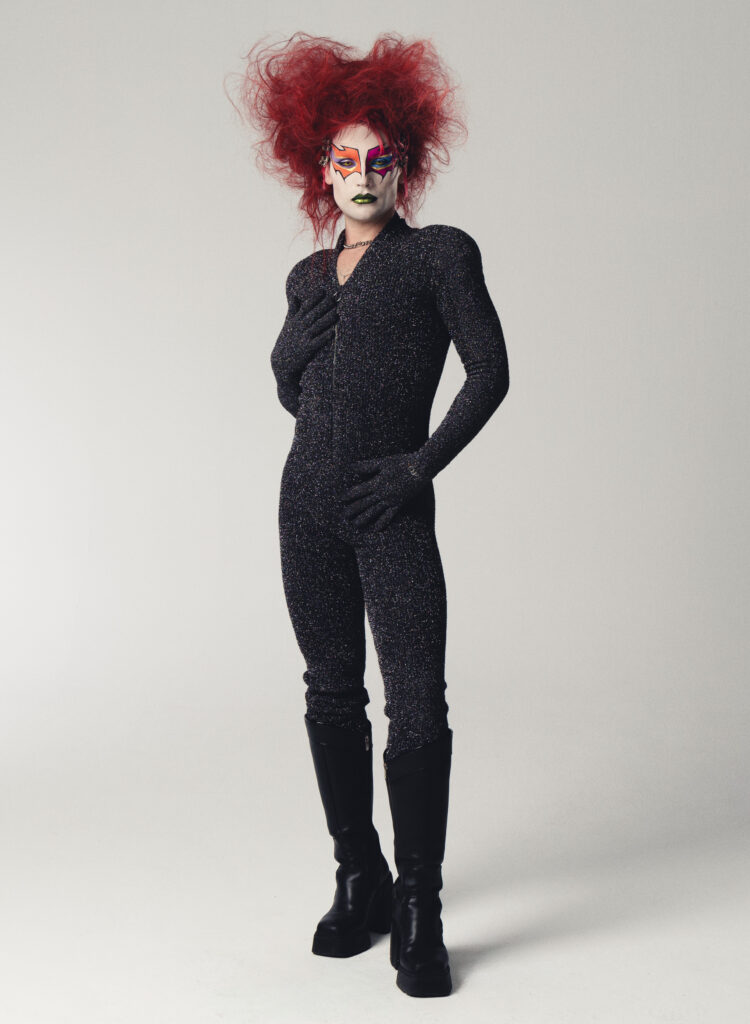
Andrew wears sparkly catsuit and chains talent’s own / On lips BYREDO BEAUTY Colour Stick in Kumato
V MAGAZINE: Tell us about your work.
ANDREW DAHLING: I’m a ‘take it as far as you can possibly go’ type of artist. I incorporate a lot of color, texture, crazy shapes, and color blocking. My work is very inspired by the early 90s, late 80s club kid era in New York and in London. The 70s London punk scene is really cool. The new Romantics and all those kids were just so revolutionary and rebellious. I like to keep that spirit going and infuse it into what I do as well.
V: What makes it possible for you to do what you do?
AD: Having the right products is key. My favorite product to use ever is the Danessa Myricks mix color fix, because it’s super high impact, super colorful, and it stays on so well. There are also meticulous techniques that require you to be intuitive—like how to hold a brush to get the line right. Because a lot of times when you do graphic shapes—your face isn’t a flat surface, obviously—you think it’s gonna look a certain way, but when you look at yourself straight on, it doesn’t create that shape that you wanted. It’s a lot of trial and error.
V: Who should everyone know about?
AD: I would say Susanne Bartsch, for sure, everything she’s done for the community. Leigh Bowery… I mean, his looks alone were so iconic, but he was such a performer and took up so much space and was absolutely hilarious. I think he’s the pinnacle of authentic self expression. I love watching his old videos. I also love John Waters and his films. Those are fabulous.
V: What is a singular work of art that everyone should experience?
AD: Anything Alexander McQueen. When I was in high school, I came to New York and visited The Met. At the time, his exhibit Savage Beauty was showing. I got to see a lot of the iconic pieces in person. There aren’t many things I remember from that era, but I feel like I could just go through my memory and clearly re-walk it, because it’s singed into my brain.
V: What possession of yours do you feel best captures your essence?
AD: This is gonna sound bad, but I was in a vintage shop in Milan and got this vintage arctic fox fur from the 80s. When I put this coat on, it just gives me the life that I need. It invigorates my soul with audacity and fabulousness. I feel like the queen that I am, you know what I mean?
V: If you could, what would you say to yourself 15 years ago?
AD: I would say you don’t have as much time as you think you do. There’s always tomorrow, yes, but tomorrow doesn’t exist. It’s all about what you do now. Calm down, do some breath work, meditate, bitch, and don’t focus so much on having to heal your traumas before you do things. Just do them anyway and let the fear move through your body. Girls, be brave. Don’t wait.
V: This is a new year’s issue. What do you want to accomplish in the new year?
AD: I want to be sitting front row at fashion week looking absolutely insane—next to Doja Cat or Kylie or somebody really big—and I just randomly found myself there. I don’t belong there. I don’t know how I got there, but somehow I’m there. And I look, I don’t want to say better than everyone, but like I can confidently say that my look is the most iconic in the room. All of a sudden, the pictures surface, and people are like, ‘Who’s this?’ And I’m like, It’s me. It’s always been me.
MARTINE ALI
After launching her eponymous jewelry brand in 2010, Martine Ali’s signature silver pieces have been spotted on everyone from Bad Bunny to Bella Hadid. Last year, Ali ventured into shoes, via multiple collaborations with Converse. Given the warm reception that collection received, we suspect 2025 will be a shining year for the raucous designer.
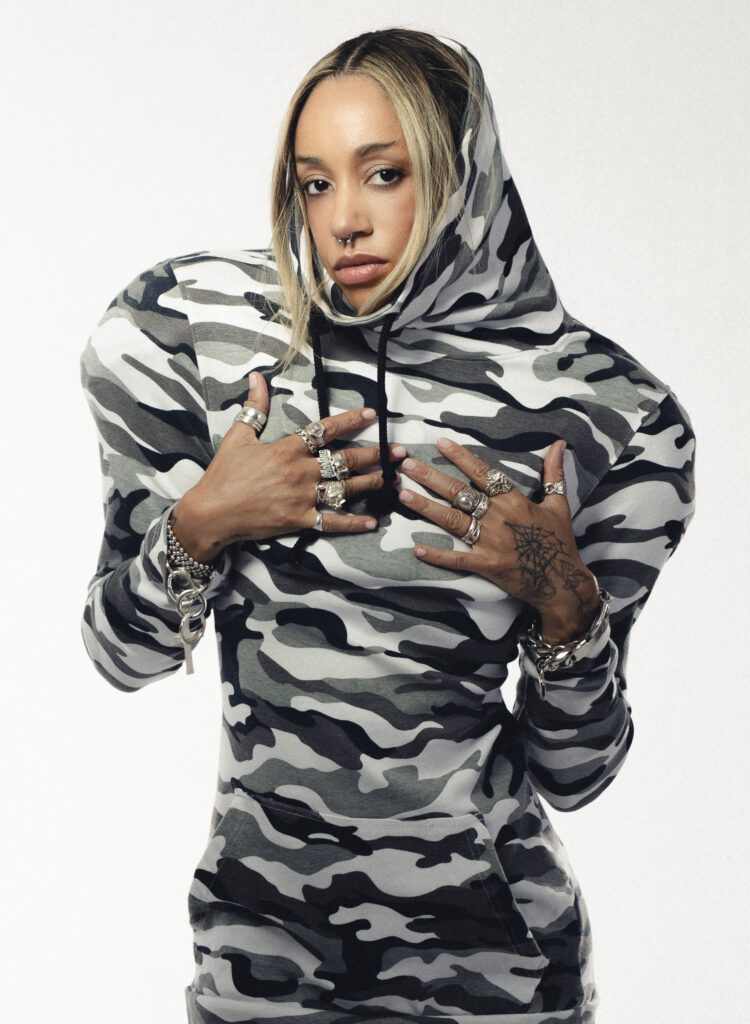
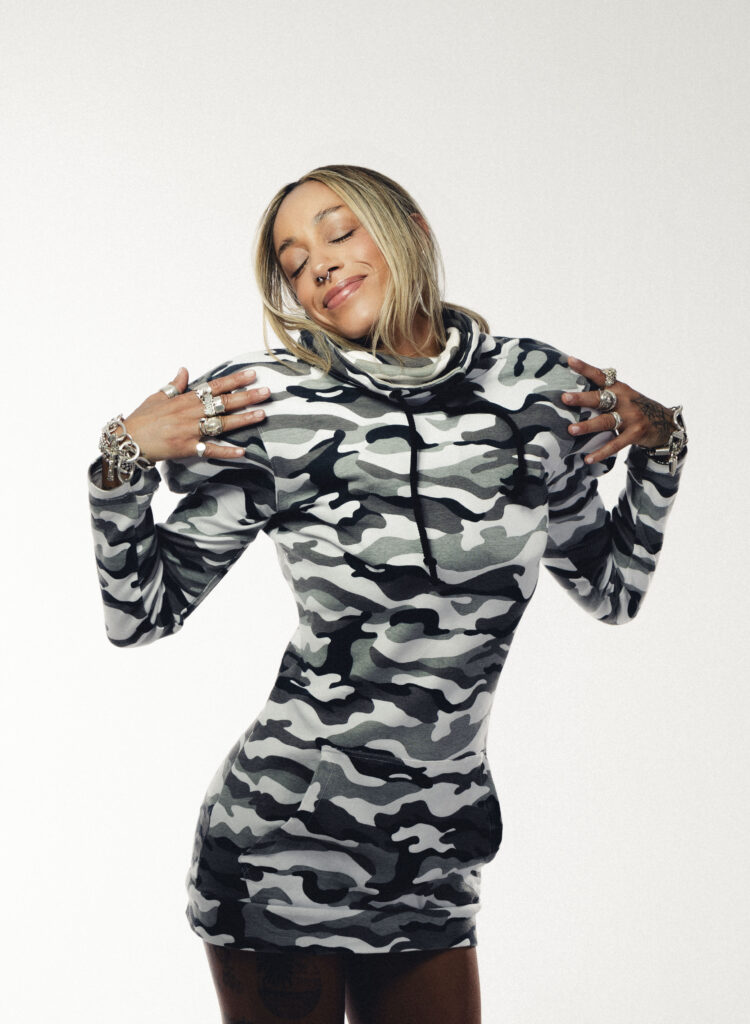
Martine wears bracelet, rings, earrings MARTINE ALI / Camouflage mini dress talent’s own / On lips SUMMER FRIDAYS Lip Butter Balm in Vanilla Beige
V MAGAZINE: Tell us about your work.
MARTINE ALI: It feels somewhat familiar… chunky silver with a hint of nostalgia, but interrupted with an unexpected and completely unnecessary, oversized infusion of hardware. I love the contrast of the familiar with the unexpected.
V: What makes it possible for you to do what you do?
MA: The few people in my life who have encouraged me to forge my own path. Also, a craving for individual style over following the pack has created this space where we need pieces to help us all tell our own story with what we wear.
V: When you decided to pursue this passion, was there anything that surprised you?
MA: No one knows what they’re doing. We’re all faking it ‘till we make it.
V: If you weren’t doing this, what would you be doing?
MA: A hair stylist, or something in interiors… maybe a hairdresser with a sick salon, or an interior designer with sick hair.
V: Who should everyone know about?
MA: We should all seek to know ourselves more.
V: What is a singular work of art that everyone should experience?
MA: Reading The Alchemist by Paulo Coelho changed my life. Experience that, please.
V: Best piece of advice you’ve ever received?
MA: Follow your heart—my godfather Denver Doggy gave me that one.
V: What possession of yours do you feel best captures your essence?
MA: This giant bag that’s in the shape of an egg. It fits everything. One should always be a giant endless well, where things just keep coming out. Like just dropping insane shit, never ending over and over again.
V: If you could, what would you say to yourself 15 years ago? What about you 15 years from now?
MA: I would tell myself 15 years ago to save all your cool shit because it’s coming back. Sign and date all your work. Become your own archive. My future self, I would tell them to accept all the growth and trust the losses and experiences as crucial to your own experience.
V: Take your flowers. What’s something you’re proud of that you did this year?
MA: Slowed down. Pulled back. Edited who and what’s part of my life. I did a lot of internal work. It’s harder to see, but really important. I’m very proud of that.
V: This is a new year’s issue. What do you want to accomplish in the new year?
MA: Intentional movement… staying five steps ahead. Wear less clothes, and crazier looks. Please and THANK YOU.
RECHO OMONDI
After years in the fashion design space, Recho Omondi decided to turn her savoir faire and love of the trade into a media platform called The Cutting Room Floor. Now entering its sixth season—with several covetable industry interviewees under her belt like Law Roach and Tonne Goodman—Omondi is feeling optimistic about her team and the year ahead.

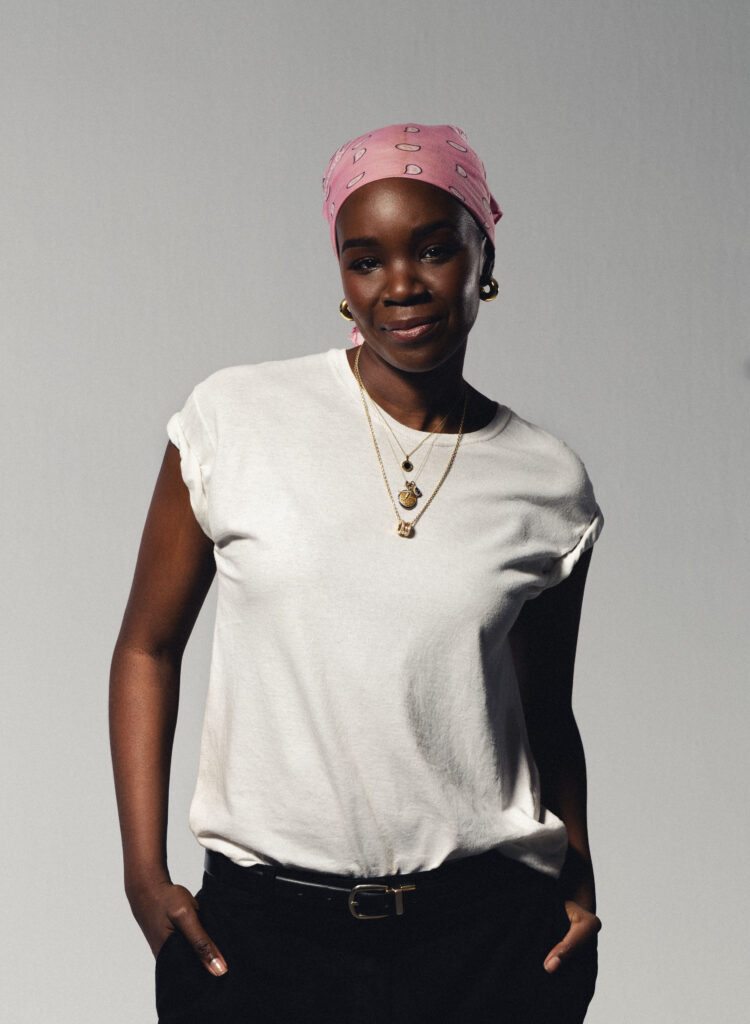
Recho wears bandana, shirt, belt, trousers, middle necklace and earrings talent’s own / Top and bottom necklace BVLGARI
V MAGAZINE: Tell us about your work.
RECHO OMONDI: My name is Recho Omondi. I’m a fashion designer and pattern maker by trade. For the last six years, most people would consider me a podcaster in the fashion media space.
V: What is a singular work of art that everyone should experience?
RO: Everyone should experience seeing a Pina Bausch show. She has a lot of shows, but Rite of Spring is a must. It will completely transform the way you see choreography, the way you think of dance, the way you think of movement and storytelling through movement in a way that’s not related to a musician or musical or movie. It’s just going to see choreography for the sake of choreography. I think that’s why she’s one of the best choreographers of all time. Rest in peace.
V: Best piece of advice you’ve ever received?
RO: I don’t know if it’s advice, but it was a statement that kind of acted as advice. It was from the esteemed retired fashion journalist Teri Agins. She said, “The hardest person to be is the person you say you are.” Ever since I heard that, which was like five years ago, it really stuck with me. It just speaks to keeping your promises, doing what you said you would do, being the person that you think you are, or that you say that you are. It’s really simple, but it’s actually really challenging.
V: If you could, what would you say to yourself 15 years ago? What about you 15 years from now?
RO: Oh, my God, pray for her. I would have cut off my friends and gotten more serious about life way sooner than I did. I think I let myself socialize longer than I wish I would have—nothing wrong with socializing, but I had a lot of the wrong people around me. 15 years from now, I’ll be 52. First of all, I think she’s gonna be so cool and so fucking chic. I think she’s gonna be cooler than I am now. I’m hoping to have some really amazing wrinkles. I think she’s gonna be a mother. I think she’s gonna be a wife. I think she’s gonna have amazing jewelry. I think she’s gonna have a lot more wisdom. I think she’s gonna have a lot more to offer. I feel like I’m still in the stage where I’m taking a lot and I want to get to a place where I’m giving away more, whether it’s advice, wisdom, time, or energy. The way I envision her, I think she’ll be more of a well.
V: This is a new year’s issue. What do you want to accomplish in the new year?
RO: The best part about my job is getting to meet people, and I do have a dream interview. However, you should include this caveat. Most of my dream interviewees are people who are press averse. Like an Olsen twin—I would take one, but I’d prefer both. I think the people that I really love are people who don’t feel like they need to talk, because their shit so good. Ann Demeulemeester… Sean Stussy… Phoebe Philo… Those are most of my icons, people who don’t want to talk. I would like to have built a career that is known for getting people who don’t talk to talk, for them to trust this platform enough to come talk to me would be like the greatest honor. That’s really the goal, especially for the 52 year old self.
SAM FINGER
After a sleazy SS25 presentation held at a Manhattan strip club—featuring New York icon Sophia Lamar and VMAN star Jonah Almost—New York born and bred designer Sam Finger has amassed a dedicated following of downtown adorers.

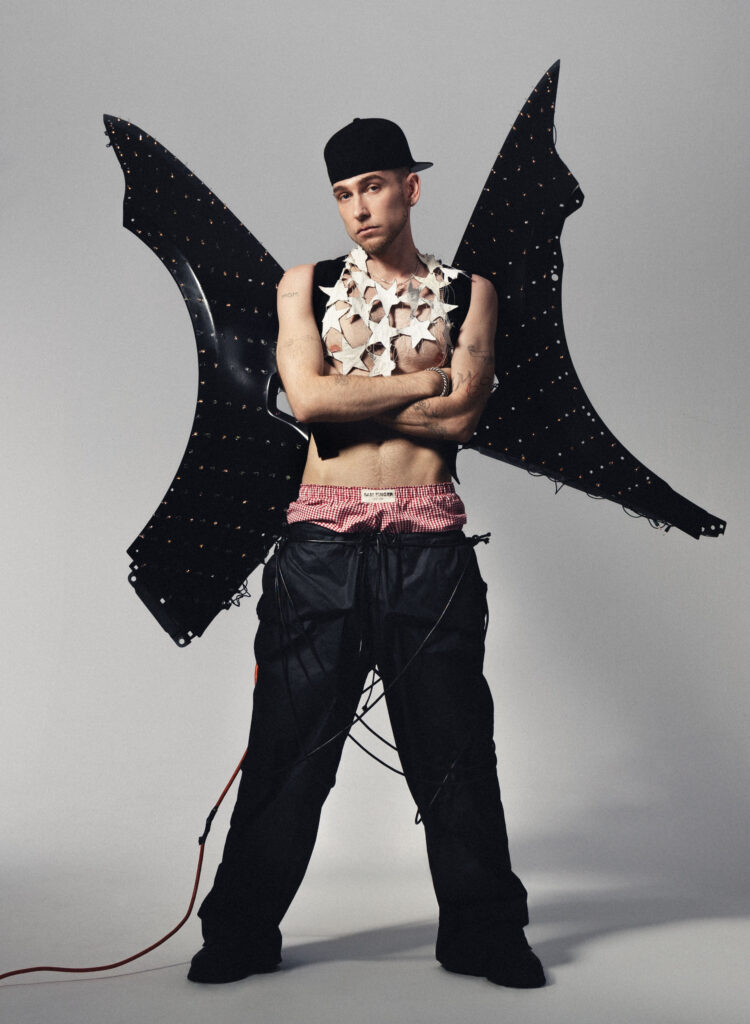
Sam wears star top, boxers, pants and wings SAM FINGER / Bracelet and hat talent’s own
V MAGAZINE: Tell us about your work.
SAM FINGER: My work is very personal, and really is about uplifting, celebrating, supporting the communities that I am a part of, but also all marginalized communities. And always repping New York City too, since I was born and raised in the East Village. Like, the look I’m wearing, it started as this idea of a fallen star. That’s how that piece started, and it was originally going to be presented with the angel wings because I wanted to give it an element of hope. I think it’s an integral part of change—whether it’s in your professional life or society at large—there’s a certain level of faith that you need to get out of hardship. The wings are actually made of Tesla car parts. To me, it was about taking this very “capitalist America” idea, especially with the controversial guy that owns it, and creating something hopeful out of it, which gives it many meanings as a brand that celebrates queer and trans identity.
V: What makes it possible for you to do what you do?
SF: Vigor. Relentlessly saying I’m going to keep doing it, regardless of whatever comes my way. And the confidence of knowing that I have a message that I want to say—and that feels like the most important thing at the end of the day.
V: When you decided to pursue this passion, was there anything that surprised you?
SF: I have a theater background, and I didn’t expect to use so much of those performance skills in the brand. It’s one thing to make the clothes, but to cast models, figure out what you want a show to look like, how you want that to be expressed, how the lighting and video affect that, is something else. The clothes are integral, but they’re just one small element of this moving piece, and that’s what really excites me. I love production. I love storytelling.
V: If you weren’t doing this, what would you be doing?
SF: Robin Hood. Stealing from the rich and giving to the poor.
V: What possession of yours do you feel best captures your essence?
SF: My grandmother gave me a gold clock made out of wood by a Mexican artist; it’s in the shape of an angel and the clock is in his chest. I have him right where you enter my apartment. My grandmother was an artist, and she was the one who supported me as an artist since I was a kid, so I feel a connection to that piece. And honestly, everything she’s ever given me.
V: If you could, what would you say to yourself 15 years ago?
SF: You’re worth it, and what you have is special and important and worth doing. There are so many moments in life where you tap into your authentic self and artistry, and somebody shoots it down, or makes fun of it, or doesn’t get it. It’s scary to put yourself out there. The only thing I regret in my life is the time I spent not trusting that feeling. But I also feel like that’s part of my journey, and I trust the story.
LIAM BENZVI
New York native, Liam Benzvi, is an American singer-songwriter and composer making waves in New York’s indie pop music scene. As a solo artist, he’s dropped two EPs—Amnesia, USA and Covers—along with two full-length albums, Acts of Service and …And His Splash Band. Keep ’em coming.


V MAGAZINE: Tell us about your work.
LIAM BENZVI: I make music. I’m a songwriter, a performer. Band leader. Producer. The list simply goes on.
V: What makes it possible for you to do what you do?
LB: An insatiable ambition. Music is honestly my lifeblood and I don’t want to live unless I’m doing it. As for forces outside of myself, I have a great manager and I have peers who make music that inspire and challenge me to do more and be better.
V: When you decided to pursue this passion, was there anything that surprised you?
LB: I used to feel like an imposter because I was more of a singer and less of an instrumentalist, even though I was fully writing songs—but it would be a long process that started with my voice note humming gibberish and a looping pedal. I surrounded myself with people who like to “jam.” Real “gear heads.” I didn’t have the same vocabulary as them. I think over time I was surprised by how many people didn’t care about what I didn’t know and that I often had something to contribute that was totally outside of their skill set.
V: If you weren’t doing this, what would you be doing?
LB: Plotting my exit.
V: Who should everyone know about?
LB: Zohran Mamdani, the current NYC mayoral candidate in the primary.
V: What is a singular work of art that everyone should experience? (Film, fashion, music, fine arts, etc)
LB: Pedro Almodovar—take your pick. Color, mania, violence, humor, tenderness, style… that’s an experience. You’ll find it all in his films.
V: Best piece of advice you’ve ever received?
LB: Time heals…
V: What possession of yours do you feel best captures your essence?
LB: I’m a big cap x sunglasses x headphones all at once person. I think my attempts to appear deeply private and in my own world whilst in public is essential to my character.
V: If you could, what would you say to yourself 15 years ago? What about you 15 years from now?
LB: To little me I’d say… don’t go to college. Just start your life now. To the future me, I’d ask… did we get the facelift? Did we leave America?
V: Take your flowers. What’s something you’re proud of that you did this year?
LB: I released an album. I’m very proud of it. It affirmed my existence. I think I know myself a lot better now.
V: This is a new year’s issue. What do you want to accomplish in the new year?
LB: I want to tour, travel, write, be in love, and get rich.
IAN KUMAMOTO
Culture Editor at Time Out New York, Ian Kumamoto is the NYC nightlife aficionado, his writing on culture, entertainment, and identity having appeared in VICE, PAPER, Them, Mic, and more. Four years ago, Ian founded Whorechata, a party collective celebrating queer people of color and their boundless creativity, and we’re buzzing to see where he’ll revel and rollick next.

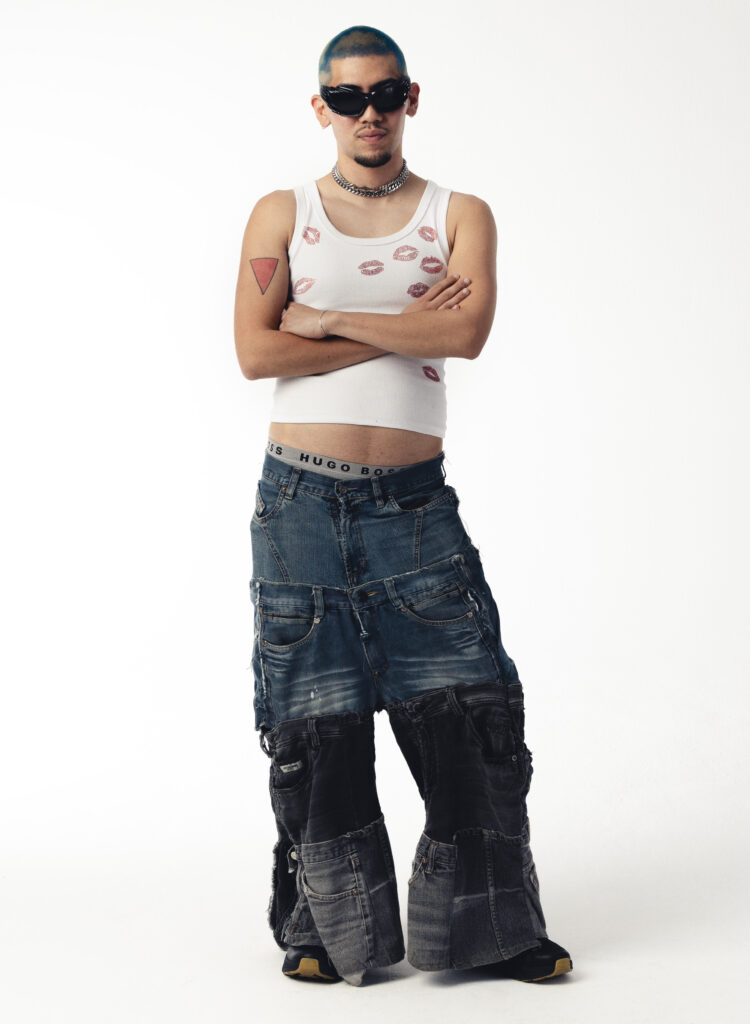
V MAGAZINE: Tell us about your work.
IAN KUMAMOTO: I started a party called Whorechata in 2021. It was sort of a response to the post-COVID reality. I didn’t want to go back to the same gay clubs, especially clubs that I felt were not for me. I’m half Mexican, half Chinese. Every time I went to Hell’s Kitchen to go out, I was so aware of my presence. I couldn’t really go out with queer women friends and trans friends, a lot of them didn’t feel comfortable. I was like, let me just get on TikTok and talk about what I want to do and see if people resonate. I asked my friend who’s also queer and who owns Ollin, a Mexican restaurant in Harlem. I was like, Do you have, like, a space I could borrow? I already made the TikTok and it went viral. I don’t know what the fuck to do. Like, now I actually need to do this. So, his aunt had a little salon where they do Quinceaneras and the capacity is, like 40 people, but over 200 people showed up. We had to turn most of the people away. But, for it being the first time, and seeing the line out the door, I was like, okay, I’m not the only one who feels this way.
V: What makes it possible for you to do what you do?
IK: Not confining myself to the world that we exist in helps me. I think everyone, not just Whorechata, but everyone who does creative stuff refuses to accept what already exists. And that’s kind of why you create. It’s just this inability to be okay with how things are. I always think of Whorechata as society flipped on its head. The people who are usually driven underground—like queer people, trans people, queer women, people of color—are actually the ones who are being centered in this alternate universe. The DJs, MCs, and hosts are always going to be queer or trans people of color, and most of the attendees are going to be that as well. So, even if it’s just for a few hours, we create this imaginary world where the hierarchies that we have to experience everywhere else are just like, so irrelevant.
V: When you decided to pursue this passion, was there anything that surprised you?
IK: I was surprised by how much people resonated with it. We’re taught, especially in capitalism, that if there’s demand, there’s going to be supply. This was one of the instances where there’s so much demand and there’s virtually no supply, and I think that’s because of who’s gatekeeping venues and nightlife—people who don’t really see it for us. Maybe it’s not even on purpose, but they just don’t function in our universe, so they don’t see it. That’s something that surprised me. Another thing that surprised me was realizing how much impact New York culture and New York nightlife has on the rest of the world. I’ve been to other countries where people will be like, Oh my God, I know Whorechata, or I’ve been to Whorechata. Sometimes we forget that everybody’s eyes are still on New York. It really motivates me because if we change the queer culture here, we can kind of change it all over the world.
V: If you weren’t doing this, what would you be doing?
IK: Sleeping? Joking. I think I would love to have a little cafe in Mexico City. Obviously, that’s so lost now. We’re taught that to aspire to office jobs and salaried jobs. But I would love a job that grounds me. Like, every day, seeing the same people, interacting with the community—just something really simple.
V: Who should everyone know about?
IK: Manchad0, he designed the pants that I’m wearing.
V: What is a singular work of art that everyone should experience?
IK: I think everybody should experience going to another city and exploring the underground culture. There’s so much that we can learn from small places where people aren’t as free to express themselves. I’ve seen the best dressed people in the most unexpected places; they put their whole lives into building themselves up in a culture that doesn’t accept them. There are so many ways of existing as queer and trans people that—as Americans and, specifically, as people who live in New York—we should try to uplift and platform them as much as we can. There’s so much untapped talent literally just existing. All they need is people with cultural power to acknowledge them.
V: Best piece of advice you’ve ever received?
IK: Someone told me that if I’m not enjoying my own events and the work that I create, why should I expect others to? And I think that came from this person seeing me very stressed and caught up in making sure the events were running smoothly. And it’s true—we should always be having fun. As soon as we stop enjoying what we’re doing, we should do something else.
V: What possession of yours do you feel best captures your essence?
IK: Definitely my journal. Nightlife dynamics can feel so cutthroat sometimes that journaling is the only way to ground and remind myself why I’m doing this. There are pages in there that I look at first thing in the morning, every morning. I feel like being able to reference those pages has helped me keep going. There have been periods where it’s been completely dead. Like, there was a party last year at a venue that fit 500 people and only 70 people came. There are moments where I’m like, I’m not it right now, but that’s okay because I know why I’m doing this.
V: If you could, what would you say to yourself 15 years ago? What about you 15 years from now?
IK: Just because it doesn’t exist or you don’t see it doesn’t mean it shouldn’t exist. Growing up Asian and Latino and queer—what place is going to actually embrace all of my identities? I never found one. The beautiful thing about that is that, when you do create it, people who aren’t even part of those identities still resonate with it. Fundamentally, people relate to you more than you think, no matter how specific or niche your identities are. 15 years from now, I’d be curious to see where I’m living. I’d be like, What are you up to?
V: Take your flowers. What’s something you’re proud of that you did this year?
IK: This shoot. 🙂
V: This is a new year’s issue. What do you want to accomplish in the new year?
IK: With the next phase of Whorechata, it’s going to be about introducing other queer communities to New York. My goal for 2025 is to bring in DJs, queer and trans, from Latin America and show people in New York that queerness is so expansive. I’m really excited to give other scenes the mic, the stage, and the space to breathe new life into our New York scene. We have a lot to learn!
RUBY ZARSKY
Best known as one-half of the electrifying musical duo Sateen, Ruby Zarsky is a driving force in New York’s queer nightlife and arts scene. From the co-founding of the downtown art gallery O’Flaherty’s to the launch of a pop-up strip club with an all-trans cast, Zarsky has played a crucial role in carving out the city’s creative topography.
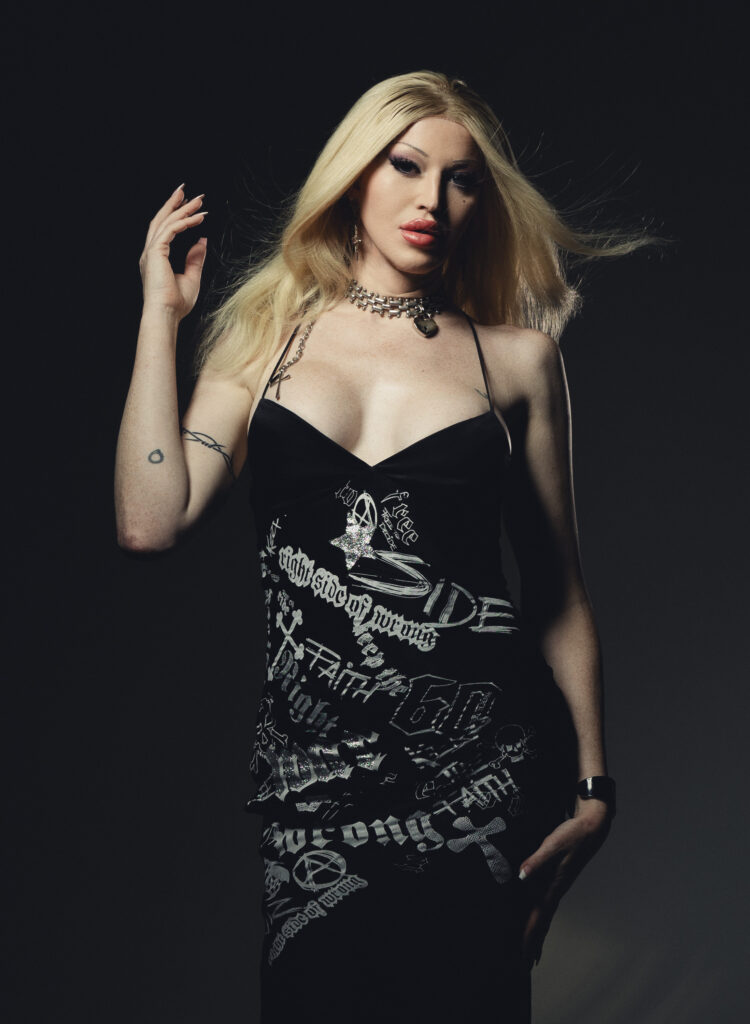
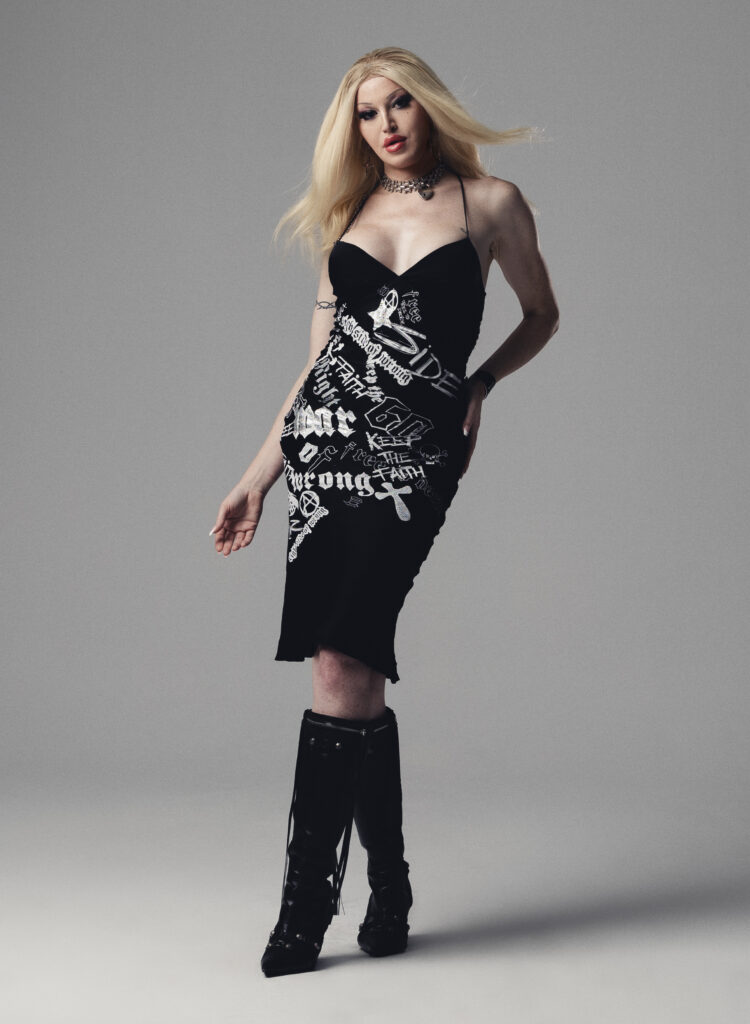
V MAGAZINE: Tell us about your work.
RUBY ZARSKY: My body of work is pretty expansive. I first became known for music in my band, Sateen. We were an independent group, so I wrote and produced all the music myself without any outside help. But I was always a fine artist, too. My work consists mostly of painting, drawing and performance. Sateen went on hiatus a couple years ago and my focus shifted to my fine arts practice. Since that time, I co-founded the experimental art gallery, O’Flaherty’s in the east village. Additionally, I put on two notable performance events that were pop-up strip clubs featuring all trans women. I also had my first solo exhibition of paintings this past February in NYC at a DIY, trans woman run space, called Intima. My second solo art show runs from November 23 through January 18 in Los Angeles at Ceradon Gallery, which is also run by two lovely trans women.
V: What makes it possible for you to do what you do?
RZ: I wouldn’t be able to do the work that I do without the support and inspiration I’ve gotten from the subculture communities I’ve been fortunate to be part of. As an adolescent in New Jersey, I participated heavily in the local punk and hardcore music scene. That community taught me about ethos and DIY. Honestly, that spirit that still carries heavily into my work. When I got a bit older and moved to NYC for art college, I began going out to nightclubs and queer parties in the city. In that scene, I met a group of queer and trans people that inspired me to explore my identity as a queer trans woman, as well as inspiring my art and music.
V: When you decided to pursue this passion, was there anything that surprised you?
RZ: In pursuing my passion I came across many things that jaded me. The kind of clout chasing and social climbing that dictate so much of success always irks me. I always believed that the work should be paramount in an artist’s value; but it just isn’t true. That said, I’ve been equally surprised by the support that I have gotten despite my stern unwillingness to participate in this kind of social climbing. I toured the country a lot with Sateen. Our fans were constantly telling me how inspiring I was to them. Many told me *in tears* how I helped them come out as gay or trans. And I know a lot of young trans musicians and young queer/trans kids saw a beacon of light in watching me do what I was doing. Those exchanges really reassured me to push forth and hold true to my ethics.
V: If you weren’t doing this, what would you be doing?
RZ: I have been doing art and music my entire life. I don’t know if I would even be alive today without the outlet these practices have provided for me. So it’s hard to imagine doing anything else. That said, I’m a Virgo and am surprisingly decent at a lot of things. Some of my other passions/interests are fashion, writing, food and gardening. I guess if I couldn’t paint or make music I would be doing something with one of those interests.
V: Who should everyone know about?
RZ: Everyone should know about a trans media mogul named Kim Christy. She was active between the 1960s-1990s. During that time she independently published a magazine called F.M.I. (Female Mimics International). She was responsible for everything including photography, text, did the design and layout of the magazine and even self-published it. She also filmed and produced many feature length porn films featuring trans women, notably the first trans porn icon, Sulka (who everyone should also know about). My favorite porn by her is called “Dream Lovers” and Sulka stars in it. I would say that, while there is a lot of sex in the movie, it is more of an erotic visual masterpiece akin to something like a Tinto Brass film.
V: What is a singular work of art that everyone should experience? (Film, fashion, music, fine arts, etc)
RZ: The all-time most formative work of art for me was Marcel Duchamp’s “Fountain”. I first saw it when I was 11 years old during a slideshow of surrealist work in my middle school art class. I remember that when I saw the image of this upturned urinal it was really shocking to me. By looking at this sculpture, I intrinsically understood something about how ideas were the actual basis for art. Prior to seeing this, I always assumed that some kind of formal skill in drawing or painting was the most important facet of great art. “Fountain” really liberated me from this narrow and untrue assumption.
V: Best piece of advice you’ve ever received?
RZ: The best piece of advice I ever received came from my drawing teacher, Georgia Marsh, while I was studying at School of Visual Arts. She explained an allegory that she felt particularly applied to me. She said I was a monkey with a jar full of nuts. I was trying to pull too many nuts out at once and my hand was getting stuck so I couldn’t get any out at all. What I needed to do was pull the nuts out one at a time if I wanted any of them to come out of the jar. Because of this advice, I actually abandoned art making completely and shifted my focus solely on music for the next 15 years. And after my band took a break, I completely abandoned music and focused back on art making. I think it has kind of disappointed a lot of fans of my music. But I really believe that I need to pull the nuts out one at a time and devote my focus on a project; rather than constantly splitting my focus on my many artistic practices.
V: What possession of yours do you feel best captures your essence?
RZ: The possession that most captures my essence is the first vial of estrogen that I injected into my thigh when I began my transition. It is probably silly that I kept it. I’ve discarded literally hundreds of them since. But transitioning is the single most important thing I’ve done in my whole life. That vial is really symbolic of me claiming my autonomy in this life. And my identity as a trans woman is absolutely the most defining thing about me. It informs all of my work. Being trans is more than just who I am. It connects me to my cultural history and a community of friends and peers that endlessly inspire me.
V: If you could, what would you say to yourself 15 years ago? What about you 15 years from now?
RZ: 15 years ago I began my exploration of my queer identity. If I could explain how deep that journey becomes I think my former self would probably burst into tears. 15 years from now I hope to gain more financial stability. It is so hard for trans women to gain upward mobility. Many, including myself, are forced to do sex work just to keep food on the table. Assuming my art career takes off, I would just remind my future self of how difficult living in incessant poverty is. And I would hope that, with my success, I can help create opportunities and pave the way for more trans women to escape survival sex work and the burdensome mental exhaustion of poverty.
V: Take your flowers. What’s something you’re proud of that you did this year?
RZ: I am beyond proud that in 2024 I had my first and second solo art exhibitions. I think my work as a musician was really groundbreaking. I am so proud of it. But these art shows symbolize a new chapter as an important figure in trans femme culture and society. After all, I am doing this for the dolls as much as I’m doing this for myself. I truly want my work to be a part of creating a brighter future for all trans women.
V: This is a new year’s issue. What do you want to accomplish in the new year?
RZ: In 2025 I want to continue my work as a fine artist. I have loved working with trans run, independent art spaces. But I would love to get representation by a more established gallery. I would also love to work with some institutional art spaces like museums. I think with that, I could make some money and create more awareness of my work. And by gaining those things my work can become more ambitious. It would also just free me from the constant mental strain of being a broke trans woman. Hopefully that freedom would allow me to finally really immerse myself in my studio practice.
This story appears in the pages of V152: now available for purchase!
Photographer Anna Henderson
Interview Savannah Sobrevilla
Hair Takayuki Umeda
Makeup Ryann Carter (Opus Beauty)
1st Photo Assistant Lamar Kendrick-Dial
Stylist Assistant AJ Grove
Digital Technician Takashi Soehl
Production Assistants Ha Chu, Gabrielle Arriaga
Discover More




















